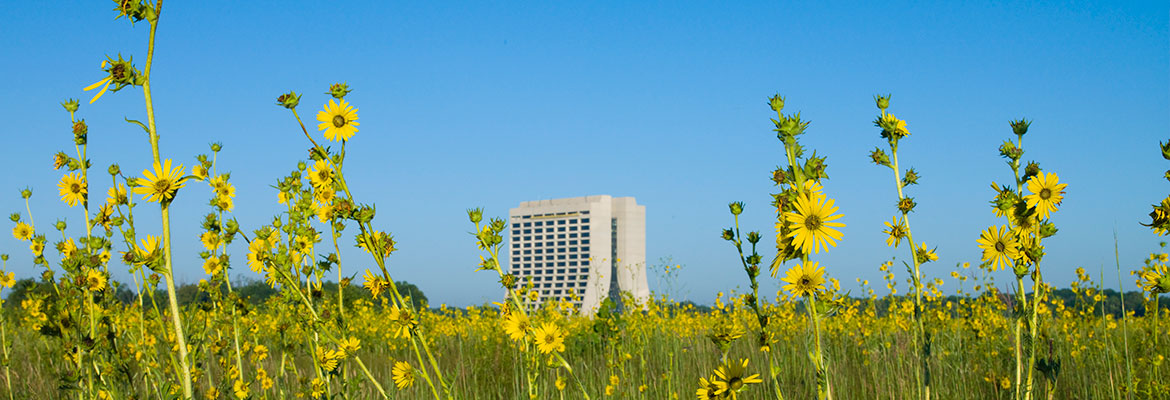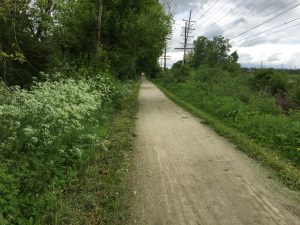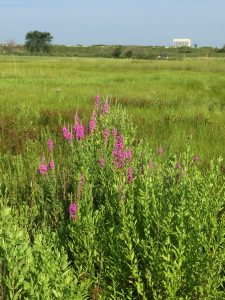After habitat loss, the second largest threat to biodiversity is the spread of invasive species.
The importance of controlling invasive species at Fermilab cannot be understated. After habitat loss, the second largest threat to biodiversity is the spread of invasive species. The Center for Invasive Species and Ecosystem Health defines invasive species as any species, including its seeds, eggs, spores, or other biological material capable of propagating that species, that is not native to that ecosystem; and whose introduction does or is likely to cause economic or environmental harm or harm to human health.
Invasive and non-native are not necessarily the same. There are many non-native species known on the Fermilab site. Most of these are not invasive and do not require control. However, those that are invasive are detrimental to ecosystem health and subvert biodiversity management efforts. Examples include common buckthorn (Rhamnus cathartica), reed canary grass (Phalaris arundinacea), cut-leaved teasel (Dipsacus laciniatus), spongy moth (Lymantria dispar), rusty crayfish (Orconectes rusticus) and emerald ash borer (Agrilus planipennis).
Land managers at Fermilab have set the following goals and objectives related to invasive species management on site.
Goal 1. Reduce the threat of rampant invasive plant species.
- Objective 1. Control reed canary grass monocultures in remnant wetlands.
- Objective 2. Control invasive woody species in remnant forests, woodlands and savannas.
- Objective 3. Control crown vetch, bird’s foot trefoil and white sweet clover in priority prairie restorations having rare species and high diversity.
Goal 2. Use early-detection, rapid-response strategy to eliminate new plant invaders known to be invasive.
- Objective 1. Eliminate currently known new invaders such as: glossy buckthorn, wild chervil, mugwort, Callery (Bradford) pear, Japanese hedge parsley and Japanese knotweed.
- Objective 2. Evaluate open and moving water habitats for aquatic invasive species such as: Brazilian elodea, water lettuce, Hydrilla, water hyacinth and flowering rush.
- Objective 3. Communicate observed and potential new invaders with regional land managers annually.
Goal 3. Eliminate or significantly decrease population size of current invasive plants by annual maintenance.
- Objective 1. Continue to remove woody invasive plant individuals in recovering forests, woodlands and savannas by volunteer stewards or periodic sweeps by staff.
- Objective 2. Continue to maintain control and track population size of herbaceous invasive plants such as: teasel, purple loosestrife, Phragmites, spotted knapweed, poison hemlock and wild parsnip.
Goal 4. When possible and practical, control non-plant invasive species via collaboration with separate agencies.
- Objective 1. Continue to support Illinois Department of Natural Resources efforts to minimize spread and detriment caused by spongy moth.
- Objective 2. Continue to allow researchers to use Fermilab as a site for investigating control of Emerald Ash Borer (EAB).
- Objective 3. Control zebra mussel spread into creeks flowing off site to help prevent downstream infestations in waterways known to have few to no individuals.
Some ornamental plants, originally bred to be sterile, have become a nuisance in natural areas where they are increasingly being found. Examples include burning bush (Euonymus alatus), Japanese barberry (Berberis thunbergii), and Bradford pear (Pyrus calleryana). Ornamental plants that are known to be invasive should be replaced in all landscaped areas at Fermilab. Replacing those plants with preferred native alternatives and preventing invasive, ornamental plants from being introduced are key components to keeping ecosystems diverse.
Furthermore, using native trees, shrubs, grasses, and wildflowers in landscaped areas is the best way to blend the built campus environment with adjacent natural areas. This is an important component of the Fermilab Campus Master Plan.



